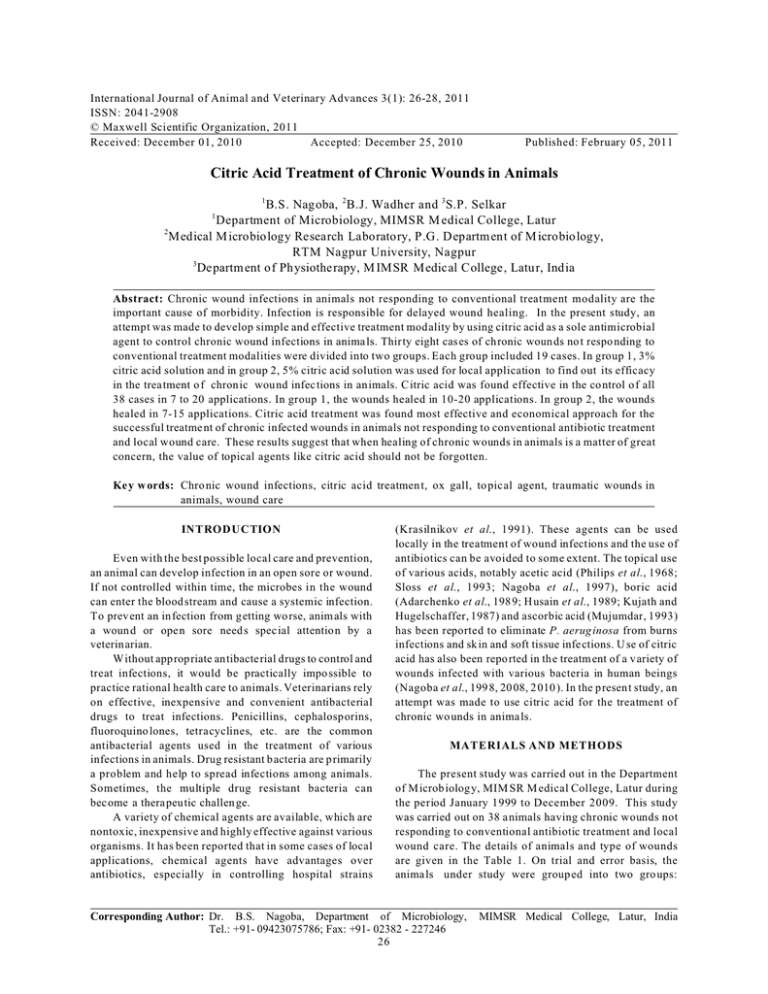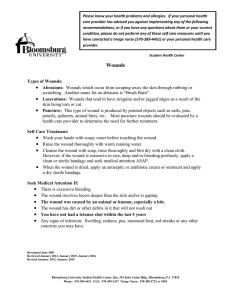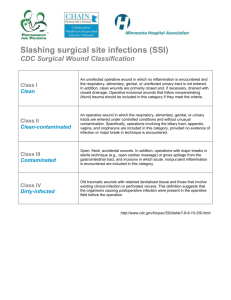International Journal of Animal and Veterinary Advances 3(1): 26-28, 2011
advertisement

International Journal of Animal and Veterinary Advances 3(1): 26-28, 2011 ISSN: 2041-2908 © Maxwell Scientific Organization, 2011 Received: December 01, 2010 Accepted: December 25, 2010 Published: February 05, 2011 Citric Acid Treatment of Chronic Wounds in Animals 1 B.S. Nagoba, 2B.J. Wadher and 3S.P. Selkar Department of Microbiology, MIMSR M edical College, Latur 2 Medical M icrobiology Research Laboratory, P.G. Departm ent of M icrobiology, RTM Nagpur University, Nagpur 3 Departm ent of Physiotherapy, M IMSR Medical College, Latur, India 1 Abstract: Chronic wound infections in animals not responding to conventional treatment modality are the important cause of morbidity. Infection is responsible for delayed wound healing. In the present study, an attempt was made to develop simple and effective treatment modality by using citric acid as a sole antimicrobial agent to control chronic wound infections in anima ls. Thirty eight cases of chronic woun ds no t respo nding to conventional treatment modalities were divided into two groups. Each group included 19 cases. In group 1, 3% citric acid solution and in group 2, 5% citric acid solution was used for local application to find out its efficacy in the treatment o f chronic wound infec tions in animals. Citric acid was found effective in the control of all 38 cases in 7 to 20 applications. In group 1, the wounds healed in 10-20 applications. In group 2, the wounds healed in 7-15 applications. Citric acid treatment was found most effective and economical approach for the successful treatme nt of chronic infected wounds in animals not responding to conventional antibiotic treatment and local wound care. These results suggest that when healing of chronic wounds in animals is a matter of great concern, the value of topical agents like citric acid should not be forgotten. Key w ords: Chro nic wound infections, citric acid treatmen t, ox gall, to pical agent, traumatic wounds in animals, wound care INTRODUCTION Even with the best possible local care and prevention, an animal can develop infection in an open sore or wound. If not controlled within time, the microbes in the wound can enter the blood stream and cause a systemic infection. To prevent an infection from getting wo rse, anim als with a woun d or open sore need s special attention by a veterinarian. Without appropriate antibacterial drugs to control and treat infections, it would be practically impo ssible to practice rational health care to animals. Veterinarians rely on effective, inexpensive and convenient antibacterial drugs to treat infections. Penicillins, cephalosporins, fluoroquino lones, tetracyclines, etc. are the common antibacterial agents used in the treatment of various infections in animals. Drug resistant b acteria are primarily a problem and help to spread infections among animals. Sometimes, the multiple drug resistant bacteria can become a therapeutic challen ge. A variety of chemical agents are available, which are nontoxic, inexpensive and highly effective against various organisms. It has been reported that in some cases of local applications, chemical agents have advantages over antibiotics, especially in controlling hospital strains (Krasilnikov et al., 1991). These agents can be used locally in the treatment of wound infections and the use of antibiotics can be avoided to some extent. The topical use of various acids, notably acetic acid (Philips et al., 1968; Sloss et al., 1993; Nagoba et al., 1997), boric acid (Adarchenko et al., 198 9; Husain et al., 1989; Kujath and Hugelschaffer, 1987) and ascorbic acid (Mujumdar, 1993) has been reported to eliminate P. aerug inosa from burns infections and sk in and soft tissue infections. U se of citric acid has also been repo rted in the treatm ent of a variety of wounds infected with various bacteria in human beings (Nagoba et al., 199 8, 20 08, 2 010 ). In the present study, an attempt was made to use citric acid for the treatment of chronic wo unds in animals. MATERIALS AND METHODS The present study was carried out in the Department of Microb iology, MIM SR M edical College, Latur during the period January 1999 to December 2009. This study was carried out on 38 animals having chronic wounds not responding to conventional antibiotic treatment and local wound care. The details of animals and type of wounds are given in the Table 1. On trial and error basis, the anima ls under study were group ed into two gro ups: Corresponding Author: Dr. B.S. Nagoba, Department of Microbiology, Tel.: +91- 09423075786; Fax: +91- 02382 - 227246 26 MIMSR Medical College, Latur, India Int. J. Anim. Veter. Adv., 3(1): 26-28, 2011 Table 1: Details of animals and type of wounds S.N o. 1 2 3 4 To tal Animal Ox Ox Buffalo Cow Type of wound Y olk g all Traumatic wound Traumatic wound Traumatic wound No. of cases -------------------------------------------------Group 1 Group 2 04 04 05 05 05 05 05 05 19 19 Total 08 10 10 10 38 Pseudomonas aeru gino sa. Citric acid has also been found effective in the treatment of a variety of wounds infected with various bacteria in human beings (Nagoba et al., 1998; Nagoba et al., 2008; Nagoba et al., 201 0). Considering the use of various acids in the effective treatment of a variety of wounds from time to time by different workers, in the present study an attempt was made to use citric acid, a natura l product obtained from citrus fruits and a well know n preservative commonly used in various edible preparations, in the treatment of animal woun ds no t respo nding to conventional treatment. Considering that citric ac id is the best among the different acids used in the treatment o f wound infections, it was used as a sole topical agent for the treatment of various animal woun ds with success rate of 100%. Citric acid was not only found to co ntrol infection but also enhanced the wound healing process, as e vident from m inimization of pus discharge and slough, and laying of granulation tissue and epithelization. Group 1 - includ ed 19 cases in which 3% citric acid solution was used for local application and Group 2 included 19 cases in which 5% citric acid solution was used for local app lication. Citric acid was used in a liquid form (3% citric acid prepared by adding 3 g of citric acid to 100 mL o f sterile distilled water and 5% citric acid prepared by adding 5 g of citric ac id to 100 mL o f sterile distilled water). For use in animals, citric acid solution (3 or 5% ) was used to irrigate and w ash the w ound , a sterile gauze soaked in citric acid was applied to wound and finally wound was dressed. In this way, citric acid was applied once daily or on alternate days based on the severity of wound infection (daily once in se verely infected wounds and on alternate days in less severe wounds). This treatment modality was used until the wound healed com pletely. No antibiotics were given during this treatm ent mo dality. RESULTS AND DISCUSSION All 38 cases responded well and heale d in 7 to 20 applications of citric acid. In a group 1, the wounds healed in 10-2 0 applications. In a group 2, the wounds healed in 7-15 applications. After application o f citric acid, pus and slough was minimized and rapid laying of granulation and epithelization was obse rved in wounds, which were not responding to earlier conventional antibio tic treatment and local wound care. No any adverse effects were noticed in any of the animals. Infection is a common reason for poor wound healing. Comp lete healing of wound can not occur in the presence of infection. The use of various acids to control wound infections cause d by Pseudom onas aeruginosa has been reported by earlier workers. No tably, use of acetic acid as a top ical agent for the treatment of supe rficial wounds infected by Pseudomonas aeruginosa has been reported from time to time by many workers (Philips et al., 1968; Sloss et al., 1993; Nagoba et al., 1997). Topical use of acetic acid at concentrations be tw ee n 0 .5 to 5% eliminate d Pseudomonas aeruginosa from burns and soft tissue wounds within two weeks of treatment (Sloss et al., 1993). In addition to acetic acid, some workers suggested use of ascorbic acid (Mujumdar, 1993) and boric acid (Adarchenko et al., 1989; Husain et al., 1989; Kujath and Hugelschaffer, 1987) for the control of wo und or b urns infections caused by CONCLUSION Use of citric acid resulted in complete healing of wounds in all 38 animals with success rate of 100%. These results indicate that citric acid treatment is a simple, reliable, nontoxic, economical and highly effective in the treatment of chronic wound infections in anima ls in which conventional treatment has been shown to yield little lasting success. These results suggest that when healing of chro nic wounds in anima ls is a matter of great conc ern, the value of topical agents like citric acid should not be forgotten. This being ob servational study, we feel that further detailed studies involving control group for comparative evaluation are necessary to ach ieve more concrete conclusions. ACKNOWLEDGMENT Authors wish to thank Prof. Dr. V.D. Karad, Executive President & Director, MAE ER’s MIT, Pune, Mr. R.K. Karad, Coordinator, Dr N.S. Arvikar, Ex Principal and Dr. Sarita Mantri, Principal, MIM SR Medical College, Latur, for their support and enco uragement. W e extend our heartfelt thanks to Dr. Ismail Makand ar, a veterinary doctor for his kind 27 Int. J. Anim. Veter. Adv., 3(1): 26-28, 2011 cooperation and to Mr. Devend ra M ule, a farmer from a village Bo rgaon, Tq. T uljapur, Dist. Osmanab ad for his special interest in this study in searching anim als with infected woun ds and their recruitment in the present study by convincing the owners. Our thanks are also due to Mr. S.S. Gutte, Miss Nameeta Surwase, Mr. S.P. Ma ne, Mr. D.L. Ghante, Mr. M.A. B hoga de, M r. Datta Shinde, Mr. Mahadeo Kaule and Mr. S.P. Kadam for technical assistance. Nagoba, B.S., S.R. D eshmukh, B .J. Wadher and S.B. Patil, 1997. Acetic acid treatment of pseudomonal posto perative wound infection. J. Hosp. Infect., 36: 243-244. Nagoba, B.S., B.J. Wadher, S.R. Deshmukh, L. Mahab aleshwar, R.C. Gandhi, P.B. Kulkarni, V.A. Mane and J.S. Deshmukh, 1998. Treatment of superficial pseudomon al infections with citric acid an effective and economical approach. J. Hosp. Infect., 40: 155-157. Nago ba, B.S., B.J. W adher, A.K . Rao, G.D . Kore, A.V. Go mashe and A.B . Ingle, 2008. Simple and effective approach for the treatme nt of chronic wound infections caused by multiple antib iotic resistant Escherichia coli. J. Hosp. Infect., 69: 177-180. Nagoba, B.S., R.C. Gandhi, B.J. Wadher, A.K. Rao, A.R. Hartalkar and S.P. Selkar, 2010. A simple and effective approach for the treatment of diabetic foot ulcers with different Wagner grades. Int. W ound J., 7: 153-158. Philips, I., A.Z. Lobo, R. Fernandes and N.S. Gundara, 1968. Acetic acid in the treatment of superficial wounds infected by Pseudomonas aerug inosa. Lancet, 1: 11-14. Sloss, J.M., N. Cumberland and S.M. Milner, 1993. Acetic acid used for the elimination of Pseudomonas aerug inosa from burn and soft tissue wound s. J. Army Med. Corps, 139: 49-51. REFERENCES Adarchenko, A.A., A.P. Krasilnikov and O.P. Sobeshchuk, 1989. Antiseptic sensitivity of clinical strains of Pseudomonas aeruginosa. Antibiotiki I Khimioterapiia, 34: 902 -907. Husain, M.T ., Q.N. Karim and S. Tajuri, 19 89. A nalysis of infection in a burn ward. Burns, 15: 299-302. Krasilnikov, A.P., A.A. Adarchenko, P.I. Bulai and O.P. Sobe shchuk, 19 91. A comp arative analysis of the antibacterial ac tivity of antiseptics and antibiotics on samp les of Pseudo mo nas aeru gino sa. Zhurnal Mikrob iologii, Epidemiologii I Immunobiologii, 8: 30-33. Kujath, P. and C. Hugelschaffer, 1987. Pseudomonas aerug inosa : Path oge nicity, p revention and therap eutic appro aches. Zentralbl Chir, 112: 558-563. Mujum dar, R.K., 1993. T reatment of resistant pseudomonas infection in burn patients in tropical climate using acetic medium, oxidizing agent and metronidazole. Indian J. Surg., 55: 501-507. 28



